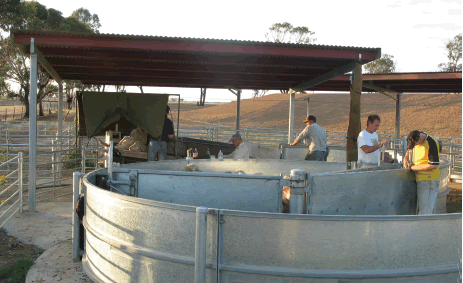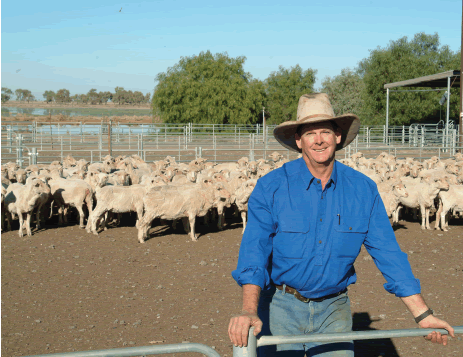 |
 |
Monitor sheep condition scores to achieve production targets while ensuring physical welfare
|
 |
Apply management practices and techniques to prevent diseases
|
 |
Use appropriate and efficient stock handling methods and well-designed facilities that exploit natural sheep behaviour
|
 |
Audit all factors that could affect sheep welfare |
|
 |
Key decisions, critical actions and benchmarks
Meet nutrition targets for all sheep classes as measured by body condition score
Ensure stock maintain recommended condition score targets (see tool 11.2). These guidelines meet production targets.
Freedom from important diseases
Basic animal welfare standards include freedom from disease. All diseases need prompt diagnosis and treatment. As a guide, aim for mortality rates of below 4% for adults and below 5% for lambs (from lamb marking to 1 year old). Major diseases, including footrot, flystrike, gastrointestinal parasites and OJD, can be well controlled with an integrated approach to management.
Follow national/state codes of practice
Currently each state has codes of practice for on-farm husbandry procedures and transport (including curfew times, animals fit for transport, minimising stress, pre-transport preparation, segregation and stocking densities, and loading and truck facilities).
The signposts section lists the codes of practice relevant to sheep enterprises.
Husbandry procedures
While routine husbandry procedures are conducted on all stock, some important aspects need to be considered:
- Plan husbandry procedures to minimise handling in order to reduce livestock stress. Where possible, combine procedures so sheep are handled less frequently.
- Public scrutiny is focused on invasive husbandry procedures that cause pain and distress to an animal. With regard to mulesing, operators are expected to be trained and registered. Alternative strategies to control flystrike are available (Visit: http://www.flyboss.org.au) and the breeding of flystrike resistant sheep should replace the need for mulesing in the longer term.
- Where an invasive procedure is considered necessary, it should be carried out at the earliest age possible by a competent operator using clean equipment and in a manner that minimises pain. See the signposts section for specific information on these procedures.
- Skilled handling of stock is very important, either by on-farm labour or accredited contractors (such as members of the Livestock Contractors Association) to provide a level of technical competence to ensure appropriate welfare standards are met.
- Best practice techniques for a range of sheep husbandry practices are described in A Producers Guide to Sheep Husbandry Practices, a publication developed by the Sheepmeat Council of Australia and MLA.
Manage ewes to improve lamb survival
While some neonatal lamb losses are inevitable, they can be significantly reduced by good management. Considerations include differential nutritional management of single- and twin-bearing ewes (see tool 10.4 in Wean More Lambs); planning and preparation of lambing paddocks with a focus on pasture availability; providing shelter; paddock topography; and control of predators during lambing.
Closely observe weather forecasts during and after shearing and muster off-shears sheep into sheltered paddocks in periods of severe weather. Sheds provide the best shelter. Dense bush is next, followed by well designed plantations in sheltered paddocks.
The energy requirements of recently shorn sheep increase by 30–50% for up to 6 weeks after shearing, so provision of adequate feed is critical during this period. As well, sheep that have been heavily grain fed, such as young lambs or pregnant ewes, are at risk of metabolic problems like hypocalcaemia (when the body fails to mobilise enough calcium from the bones to maintain normal blood calcium levels). Vulnerable sheep should not be deprived of feed longer than necessary. Feed good quality hay or a calcium drench to minimise metabolic problems.
 Management of sheep after shearing Management of sheep after shearing
Shearing is stressful for sheep so effective management is critical. Sheep are most at risk for the first 2 weeks after shearing, but losses can occur for up to 4 weeks in cold, wet and windy weather. Sheep less than 2 years old and those in poor body condition are especially at risk.
Managing sheep in drought
Implement a disaster management plan when sheep come under increased stress from naturally occurring events.
This package does not contain detailed drought feeding information. However, StockPlan® is a suite of computer decision support tools that enables sheep producers to explore options during a drought and to make informative and timely decisions before the onset of a full-blown drought. StockPlan® helps to answer questions such as:
- How much will it cost to feed my stock for a specified time?
- How will my decision affect my flock and financial position this year? And next year?
- Is it better to buy or breed in the recovery phase?
The main aim of these decision tools is to help sheep producers make management decisions that minimise the environmental and financial impacts of drought.
Sheep handling system
Keep sheep handling to the minimum level necessary to avoid unnecessary distress. Design handling facilities (shearing sheds, yards, laneways and sheep handlers) to minimise the risk of injury to sheep and to take advantage of natural sheep behaviour. Some important features include:
- Design yards to ensure a smooth flow of stock, with long, narrow forcing races (1. 5 m) so sheep move in one direction
- Bugle-type designs work well as they give sheep the sense of an escape route, operators have access to sheep that baulk and sheep do not see the operator as they enter the draft
- Sheep generally move better on flat ground or on an incline
- Ramps should have a slope of less than 1:3
- Avoid shadows in yards which can cause sheep to baulk
- Front of raceways should be open so sheep do not see a dead end
- Sheep tend to move better and remain calmer if they see other animals within touching distance
- Use materials that do not make a noise and are designed to avoid potential injury to sheep
- Maintain sheep handling facilities in good working order and complete repairs well before major husbandry practices are carried out
- Provide non-slip flooring.
 Stockmanship and education Stockmanship and education
Stockmanship is a broad term that encompasses the expertise of people involved in handling stock. Sheep handling methods are very important for ease of movement, increasing productivity and reducing OH&S issues.
Understanding sheep behaviour is an important part of good stockmanship and improves a handler’s ability to move stock whilst minimising stress. Key characteristics of sheep behaviour include:
- Sheep are herd animals – they exhibit flocking behaviour and like to follow each other
- A separated sheep will always attempt to return to the mob
- Breeds are different - Merinos prefer to flock as a single group, Southdowns form a few subgroups and Dorset sheep always form subgroups
- In a flock situation there is little dominance but in competitive feeding situations hierarchies occur
- Sheep tend to graze up-wind in warm weather and down-wind in cold weather. This is important to consider when designing shelter belts, and especially for the management of freshly shorn sheep
- Avoid sudden jerking movements and loud noise. Apply optimal pressure rather than excessive pressure to exploit the sheep’s flight zone. If a sheep moves away, the handler has penetrated the flight zone. If the animal is looking at the handler, the handler is outside the flight zone
- Sheep like to see what is pressuring them. When pressured too much they will try to cut back. Attempt to move the lead animals by positioning yourself in the flight zone, rather than forcing from behind
- Use dogs carefully. Muzzle dogs that bite and tie them up when they are not working.
Selection for temperament may improve animal behaviour and stock handling.
Signposts  |
Read
Codes of practice
The Australian Animal Welfare Standards and Guidelines for Sheep. Visit: www.animalwelfarestandards.net.au/sheep/
Model Code of Practice for Welfare of Animals: Animals at Saleyards. Visit: www.publish.csiro.au/nid/22/pid/367.htm
Codes of accepted farming practice for the welfare of sheep, saleyards and transport are available from all State Government offices and Departments of Primary Industries/Agriculture websites.
‘Is it fit to load? A national guide to the selection of animals fit to transport’. Download here.
Land Transport Standards and Guidelines - Sheep Best Practice Husbandry Guide visit www.animalwelfarestandards.net.au
Handling facilities
Sheep Yard and Shearing Shed Design (1994) edited by Fiona Conroy and Peter Hanrahan. Agriculture Victoria.
Electronic versions of the out-of-print
books Yards and Yakka (sheep
yard design) and Shear Sense
(wool harvesting) are available from
the Kondinin Group. Order these
publications by:
Sheep yard design, NSW DPI. Visit: www.dpi.nsw.gov.au/animals-and-livestock/sheep/yards-equipment
AWI information on shearing shed and yard design. Visit: www.wool.com/on-farm-research-and-development/wool-harvesting-and-quality-preparation/shearing-sheds-and-sheep-yards/
View
AWI is developing alternatives to conventional mulesing for the cost effective control of breech blowfly strike. Keep up to date with the latest developments at: www.wool.com/on-farm-research-and-development/sheep-health-welfare-and-productivity/sheep-health/breech-flystrike/
This animal behaviour website describes sheep vision and other special senses; social organisation and dominance hierarchies; sexual behaviour; maternaloffspring behaviour; and abnormal behaviour. Visit: www.animalbehaviour.net/farm-animals/sheep/
A Producers Guide to Sheep Husbandry Practices. Produced by the Sheepmeat Council of Australia and MLA. Click here to download, or search at MLA Publications (http://www.mla.com.au/News-and-resources/Publications).
Managing sheep in droughtlots, A best practice guide. Order your free copy from AWI by:
Attend
PROfarm is the training program developed by NSW DPI to meet the needs of farmers, primary industries, agribusiness and the community. NSW DPI PROfarm short courses are available by contacting:
The PROfarm courses most relevant to this procedure are:
- Stock Safe – improve safe handling skills of stock on farm, reduce the risk of injury to those working with livestock, and raise awareness of animal wellbeing as an issue of public concern.
- StockPlan® – a workshop to help sheep (and cattle) producers explore management options in the preliminary stages and during drought.
Low stress stock handling courses emphasise mutually beneficial outcomes for stock and handlers regardless of yard design. Visit the following websites to find out more:
Apps
The Veterinary Handbook for Sheep, Cattle and Goats: Produced by Livecorp, available for iOS and Android. Allows users to search by species, disease or syndrome to instantly access veterinary advice. Can be used offline.
|
|